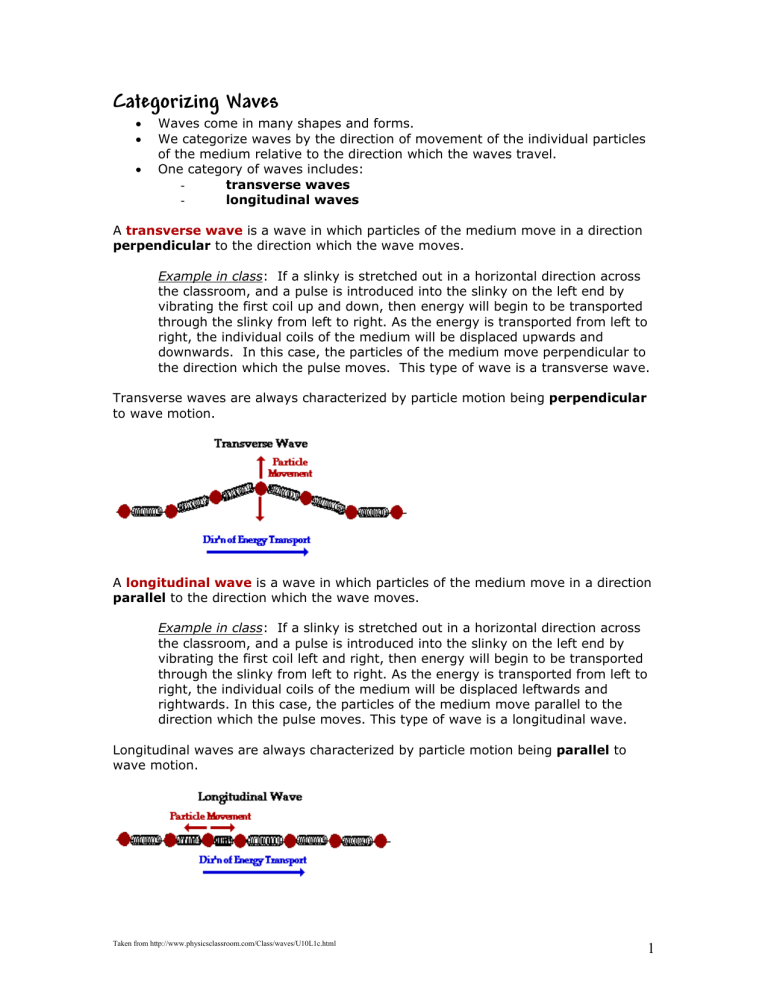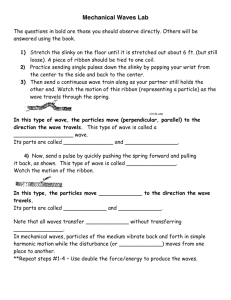The frequency of a wave refers to how often the particles of the

Categorizing Waves
• Waves come in many shapes and forms.
• We categorize waves by the direction of movement of the individual particles of the medium relative to the direction which the waves travel.
• One category of waves includes:
transverse waves longitudinal waves
-
A transverse wave is a wave in which particles of the medium move in a direction
perpendicular to the direction which the wave moves.
Example in class: If a slinky is stretched out in a horizontal direction across the classroom, and a pulse is introduced into the slinky on the left end by vibrating the first coil up and down, then energy will begin to be transported through the slinky from left to right. As the energy is transported from left to right, the individual coils of the medium will be displaced upwards and downwards. In this case, the particles of the medium move perpendicular to the direction which the pulse moves. This type of wave is a transverse wave.
Transverse waves are always characterized by particle motion being perpendicular to wave motion.
A longitudinal wave is a wave in which particles of the medium move in a direction
parallel to the direction which the wave moves.
Example in class: If a slinky is stretched out in a horizontal direction across the classroom, and a pulse is introduced into the slinky on the left end by vibrating the first coil left and right, then energy will begin to be transported through the slinky from left to right. As the energy is transported from left to right, the individual coils of the medium will be displaced leftwards and rightwards. In this case, the particles of the medium move parallel to the direction which the pulse moves. This type of wave is a longitudinal wave.
Longitudinal waves are always characterized by particle motion being parallel to wave motion.
Taken from http://www.physicsclassroom.com/Class/waves/U10L1c.html 1
A sound wave is a classic example of a
longitudinal wave
. As a sound wave moves from the lips of a speaker to the ear of a listener, particles of air vibrate back and forth in the same direction. The sound bounces off the air particles in a back and forth motion.
Waves traveling through a solid medium can be either
transverse waves
or
longitudinal waves
. Earthquakes are capable of producing both transverse and longitudinal waves which travel through the solid structures of the Earth. When seismologists began to study earthquake waves they noticed that only longitudinal waves were capable of traveling through the core of the Earth. This is why geologists believe that the Earth's core consists of a liquid—most likely molten iron.
Yet waves traveling through a fluid (such as a liquid or a gas) are always
longitudinal waves
. These waves have been observed moving through the bulk of liquids such as our oceans.
Transverse waves
require a relatively rigid medium in order to transmit their energy.
Light is a transverse wave, since it can travel through a vacuum (empty space) and does not require any particles to bounce off.
Creating Waves:
If you wish to create a transverse wave in a slinky, then the first coil of the slinky must be displaced in a direction perpendicular to the entire slinky. Similarly, if you wish to create a longitudinal wave in a slinky, then the first coil of the slinky must be displaced in a direction parallel to the entire slinky.
Taken from http://www.physicsclassroom.com/Class/waves/U10L1c.html 2
Another way to categorize waves:
Another way to categorize waves is on the basis of the ability (or non-ability) to transmit energy through a vacuum (empty space). Categorizing waves on this basis leads to two notable categories:
-
electromagnetic waves mechanical waves
An electromagnetic wave is a wave which is capable of transmitting its energy through a vacuum. The sun's light rays are examples of electromagnetic waves.
These waves travel from the surface of the sun through the vacuum of outer space, reaching Earth. Were it not for the ability of electromagnetic waves to travel to
Earth, there would undoubtedly be no life on Earth. All light waves are examples of electromagnetic waves.
A mechanical wave is a wave which is not capable of transmitting its energy through a vacuum. Mechanical waves require a medium in order to transport their energy from one location to another. A sound wave is an example of a mechanical wave. Sound waves are incapable of traveling through a vacuum. Slinky waves, water waves, and stadium waves are other examples of mechanical waves; each requires some medium in order to exist. A slinky wave requires the coils of the slinky; a water wave requires water; and a stadium wave requires fans in a stadium.
***The above categories represent just a few of the ways which physicists categorize waves in order to compare and contrast their behaviors and characteristic properties. This listing of categories is not exhaustive; there are plenty of other categories.
Taken from http://www.physicsclassroom.com/Class/waves/U10L1c.html 3
More on Transverse Waves
The frequency of a wave refers to how often the particles of the medium vibrate when a wave passes through the medium.
Frequency is a part of our common, everyday language. For example, it is not uncommon to hear a question like "How frequently do you mow the lawn during the summer months?" Of course the question is an inquiry about how often the lawn is mowed and the answer is usually given in the form of "1 time per week.")
In mathematical terms, the frequency is the number of complete vibrational cycles of a medium per a given amount of time.
Given this definition, it is reasonable that some units describing frequency would be cycles/second, waves/second, vibrations/second, or something/second. Another unit for frequency is the Hertz (abbreviated Hz) where 1 Hz is equivalent to 1 cycle/second.
When an event occurs repeatedly, then we say that the event is periodic and refer to the time for the event to repeat itself as the period. The period of a wave is the time for a particle on a medium to make one complete vibrational cycle. It is measured in seconds/cycle.
Period, being a time, is measured in units of time such as seconds, hours, days or years.
In mathematics, the amplitude refers to the magnitude of the oscillation.
Taken from http://www.physicsclassroom.com/Class/waves/U10L1c.html 4








